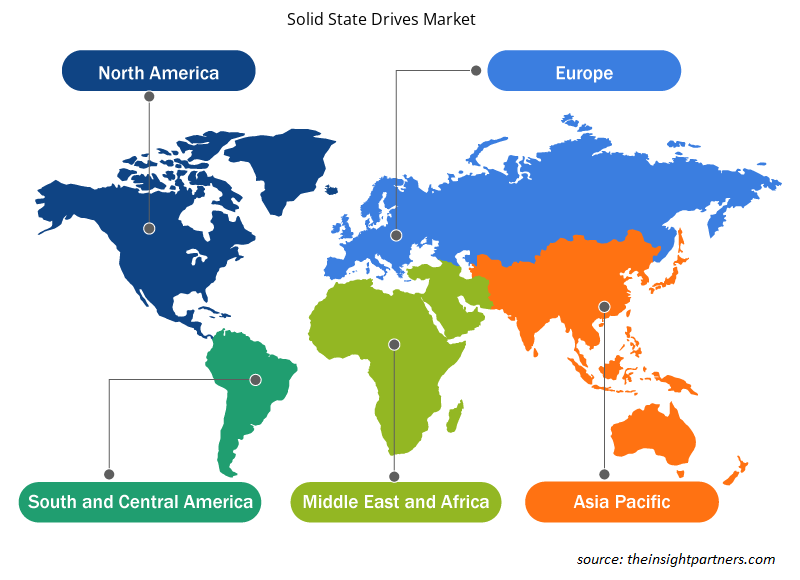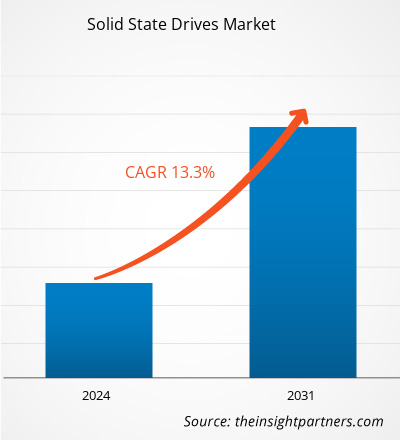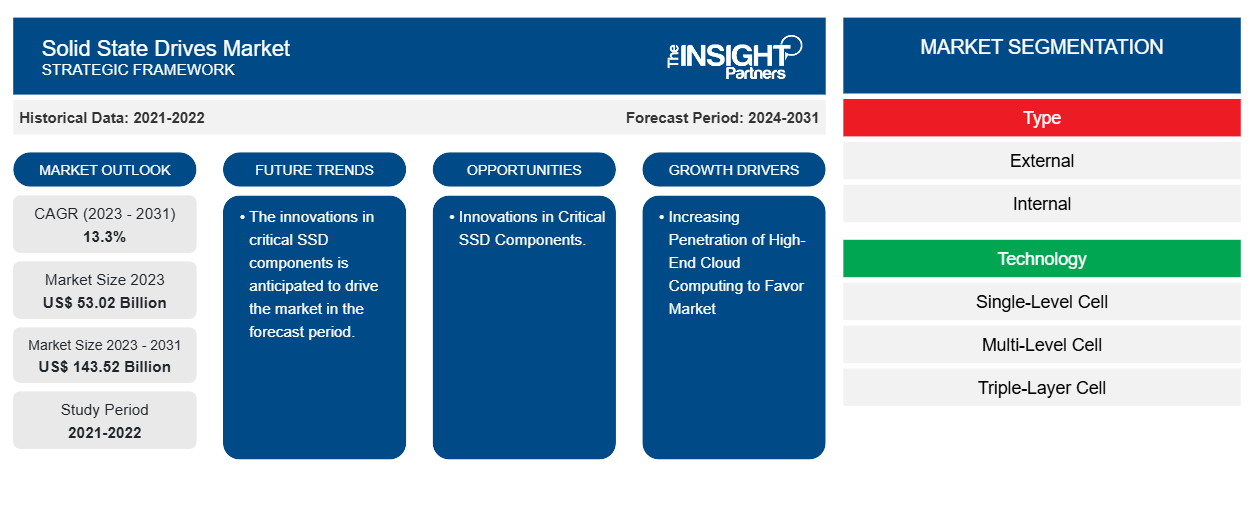Der Markt für Solid-State-Laufwerke soll von 53,02 Milliarden US-Dollar im Jahr 2023 auf 143,52 Milliarden US-Dollar im Jahr 2031 anwachsen. Der Markt soll zwischen 2023 und 2031 eine durchschnittliche jährliche Wachstumsrate (CAGR) von 13,3 % verzeichnen. Die zunehmende Verbreitung von High-End-Cloud-Computing und die zunehmende Nutzung von Rechenzentrumsanwendungen dürften die wichtigsten Treiber und Trends des Marktes sein.
Marktanalyse für Solid-State-Laufwerke
Der Markt für Solid-State-Laufwerke verzeichnet weltweit ein deutliches Wachstum. Dieses Wachstum ist auf Faktoren wie die zunehmende Verbreitung von High-End -Cloud-Computing und die zunehmende Nutzung von Rechenzentrumsanwendungen zurückzuführen. Darüber hinaus wird erwartet, dass relationale Analysen mithilfe intelligenter SSDs und Innovationen bei kritischen SSD-Komponenten das Marktwachstum in der kommenden Zeit vorantreiben werden.
Marktübersicht für Solid-State-Laufwerke
Ein Solid-State-Laufwerk (SSD) ist eine neue Generation von Speichergeräten, die in Computern verwendet werden. SSDs speichern Daten mithilfe von Flash-basiertem Speicher, der schneller ist als herkömmliche Festplatten. SSDs haben außerdem keine beweglichen Teile, und ein Upgrade auf ein solches Laufwerk ist eine Möglichkeit, den Computer zu beschleunigen und leistungsfähiger zu machen.
Passen Sie diesen Bericht Ihren Anforderungen an
Sie erhalten kostenlos individuelle Anpassungen an jedem Bericht, einschließlich Teilen dieses Berichts oder einer Analyse auf Länderebene, eines Excel-Datenpakets sowie tolle Angebote und Rabatte für Start-ups und Universitäten.
-
Holen Sie sich die wichtigsten Markttrends aus diesem Bericht.Dieses KOSTENLOSE Beispiel umfasst eine Datenanalyse von Markttrends bis hin zu Schätzungen und Prognosen.
Treiber und Chancen auf dem Markt für Solid-State-Laufwerke
Zunehmende Verbreitung von High-End-Cloud-Computing begünstigt den Markt
Die SSD-Cloud-Server nutzen die Leistung des Cloud-Computing und verwenden Solid-State-Laufwerke (SSDs) zur Speicherung. Wenn ein SSD-Cloud-Server verwendet wird, werden die Daten und Anwendungen auf Hochgeschwindigkeits-SSDs gespeichert, was einen schnelleren Zugriff und eine schnellere Datenverarbeitung ermöglicht als Festplattenlaufwerke (HDDs). SSD-Cloud-Server bieten Skalierbarkeit, Zuverlässigkeit und schnelle Leistung und sind daher ideal für Unternehmen jeder Größe. Kleine und mittlere Unternehmen (KMU) finden sie aufgrund ihrer kostengünstigen Lösungen besonders vorteilhaft, ohne Kompromisse bei Geschwindigkeit oder Speicherkapazität eingehen zu müssen. Der SSD-Cloud-Server kann für eine Vielzahl von Anwendungen genutzt werden. Anwendungen wie Geschäftsinhaber, Unternehmer, Start-ups, Marktplätze, Einzelhändler, Software, IT-Experten usw.
Innovationen bei kritischen SSD-Komponenten.
Externe SSDs von Crucial sind schneller als herkömmliche Festplatten und funktionieren mit einer Vielzahl von Geräten. Mit den portablen SSDs Crucial X9 Pro, X10 Pro, X9 Pro für Mac, X9 und X6 können Sie Dateien, Backups, Filme, Spiele oder Fotos erstellen. Die Entwicklung der SSD-Kapazitäten ist bemerkenswert und revolutioniert die Möglichkeiten der Datenspeicherung. Darüber hinaus haben technologische Fortschritte wie 3D NAND die Speicherdichte erhöht und gleichzeitig die Lebensdauer und Zuverlässigkeit verbessert. Multi-Level-Cell- (MLC) und Triple-Level-Cell- (TLC) Technologien haben eine entscheidende Rolle bei der Entwicklung dieser SSDs mit höherer Kapazität gespielt, da sie die Speicherung von mehr Daten in Speicherzellen ermöglichen.
Segmentierungsanalyse des Marktberichts für Solid-State-Laufwerke
Wichtige Segmente, die zur Ableitung der Marktanalyse für Solid-State-Laufwerke beigetragen haben, sind Typ, Technologie, Speicher und Endbenutzer.
- Basierend auf dem Typ wird der Markt für Solid-State-Laufwerke in externe und interne unterteilt. Das Segment der Power-Management-Komponenten dürfte im Prognosezeitraum einen erheblichen Marktanteil halten.
- Basierend auf der Herstellungstechnik ist der Markt für Festkörperlaufwerke in Single-Level-Zellen (SLC), Multi-Level-Zellen (MLC) und Triple-Layer-Zellen (TLC) unterteilt. Das Segment der Single-Level-Zellen (SLC) wird im Prognosezeitraum voraussichtlich einen erheblichen Marktanteil halten.SLC), multi-level cells (MLC), and triple-layer cells (TLC). The single-level cell (SLC) segment is anticipated to hold a significant market share in the forecast period.
- Der Markt ist nach Speicher segmentiert in Unter 500 GB, 500 GB-1 TB, 1 TB-2 TB und Über 2 TB. Das Segment Unter 500 GB dürfte im Prognosezeitraum einen erheblichen Marktanteil halten.
- Nach Endverbraucher ist der Markt in die Segmente Industrie, Automobil, Unternehmen und Privatkunden unterteilt; das sonstige Segment dürfte im Prognosezeitraum einen signifikanten Marktanteil halten.
Marktanteilsanalyse für Solid-State-Laufwerke nach geografischer Lage
Der geografische Umfang des Marktberichts für Solid-State-Laufwerke ist hauptsächlich in fünf Regionen unterteilt: Nordamerika, Asien-Pazifik, Europa, Naher Osten und Afrika sowie Süd- und Mittelamerika.
Nordamerika dominiert den Markt für Festkörperlaufwerke. Die hohen Technologieannahmetrends in verschiedenen Branchen in der nordamerikanischen Region haben das Wachstum des Marktes für Festkörperlaufwerke vorangetrieben. Faktoren wie die zunehmende Nutzung digitaler Tools und hohe Technologieausgaben von Regierungsbehörden dürften das Wachstum des nordamerikanischen Marktes für Festkörperlaufwerke vorantreiben. Darüber hinaus zwingt eine starke Betonung von Forschung und Entwicklung in den entwickelten Volkswirtschaften der USA und Kanadas die nordamerikanischen Akteure dazu , technologisch fortschrittliche Lösungen auf den Markt zu bringen. Darüber hinaus gibt es in den USA eine große Anzahl von Festkörper-Marktteilnehmern, die sich zunehmend auf die Entwicklung innovativer Lösungen konzentrieren. All diese Faktoren tragen zum Wachstum des Marktes für Festkörperlaufwerke in der Region bei.
Regionale Einblicke in den Markt für Solid-State-Laufwerke
Die regionalen Trends und Faktoren, die den Markt für Solid-State-Laufwerke im Prognosezeitraum beeinflussen, wurden von den Analysten von Insight Partners ausführlich erläutert. In diesem Abschnitt werden auch die Marktsegmente und die Geografie für Solid-State-Laufwerke in Nordamerika, Europa, im asiatisch-pazifischen Raum, im Nahen Osten und Afrika sowie in Süd- und Mittelamerika erörtert.

- Holen Sie sich die regionalen Daten für den Solid-State-Laufwerke-Markt
Umfang des Marktberichts zu Solid-State-Laufwerken
| Berichtsattribut | Details |
|---|---|
| Marktgröße im Jahr 2023 | 53,02 Milliarden US-Dollar |
| Marktgröße bis 2031 | 143,52 Milliarden US-Dollar |
| Globale CAGR (2023 - 2031) | 13,3 % |
| Historische Daten | 2021-2022 |
| Prognosezeitraum | 2024–2031 |
| Abgedeckte Segmente |
Nach Typ
|
| Abgedeckte Regionen und Länder |
Nordamerika
|
| Marktführer und wichtige Unternehmensprofile |
|
Marktteilnehmerdichte bei Solid-State-Laufwerken: Auswirkungen auf die Geschäftsdynamik verstehen
Der Markt für Solid-State-Laufwerke wächst rasant. Dies wird durch die steigende Nachfrage der Endnutzer aufgrund von Faktoren wie sich entwickelnden Verbraucherpräferenzen, technologischen Fortschritten und einem größeren Bewusstsein für die Vorteile des Produkts vorangetrieben. Mit der steigenden Nachfrage erweitern Unternehmen ihr Angebot, entwickeln Innovationen, um die Bedürfnisse der Verbraucher zu erfüllen, und nutzen neue Trends, was das Marktwachstum weiter ankurbelt.
Die Marktteilnehmerdichte bezieht sich auf die Verteilung der Firmen oder Unternehmen, die in einem bestimmten Markt oder einer bestimmten Branche tätig sind. Sie gibt an, wie viele Wettbewerber (Marktteilnehmer) in einem bestimmten Marktraum im Verhältnis zu seiner Größe oder seinem gesamten Marktwert präsent sind.
Die wichtigsten auf dem Markt für Solid-State-Laufwerke tätigen Unternehmen sind:
- Kingston Technology Europe Co LLP
- SK Hynix Inc.
- Micron Technology, Inc
- Microsemi Corporation
- Samsung-Gruppe
- KIOXIA Corporation
Haftungsausschluss : Die oben aufgeführten Unternehmen sind nicht in einer bestimmten Reihenfolge aufgeführt.

- Überblick über die wichtigsten Akteure auf dem Markt für Solid-State-Laufwerke
Neuigkeiten und aktuelle Entwicklungen zum Solid-State-Laufwerk-Markt
Der Markt für Festkörperlaufwerke wird durch die Erhebung qualitativer und quantitativer Daten nach Primär- und Sekundärforschung bewertet, die wichtige Unternehmensveröffentlichungen, Verbandsdaten und Datenbanken umfasst. Nachfolgend sind einige der Entwicklungen auf dem Markt für Festkörperlaufwerke aufgeführt:
- Da die digitale Transformation aufgrund der kontinuierlichen Weiterentwicklung der künstlichen Intelligenz (KI) und der rasanten Fortschritte im Cloud-Computing immer unabdingbarer wird, steigt der Bedarf der Unternehmen an Datenverarbeitung und -speicherung. Um dieser wachsenden Nachfrage gerecht zu werden, hat STC (eine Tochtergesellschaft von Kioxia) die CL6-Serie von SSDs in Industriequalität auf den Markt gebracht, die weltweit ersten, die mit dem BiCS FLASH™ 3D-Flash-Speicher der sechsten Generation von KIOXIA ausgestattet sind. (Quelle: STC-Unternehmenswebsite, September 2023)
- Seagate Technology Holdings plc, ein weltweit führender Anbieter von Massendaten-Speicherinfrastrukturlösungen, und Phison Electronics Corp, ein weltweit führender Anbieter von NAND-Flash-Controller- und Speicherlösungen, gaben heute Pläne zur Erweiterung ihres SSD-Portfolios um hochleistungsfähige, hochdichte Enterprise-NVMe-SSDs der nächsten Generation bekannt. Die neuen SSDs werden Unternehmen dabei helfen, die Gesamtbetriebskosten (TCO) durch höhere Speicherdichte, geringeren Stromverbrauch und höhere Leistung zu senken. (Quelle: Seagate Technology Holdings plc Unternehmenswebsite, April 2022)
Marktbericht zu Solid-State-Laufwerken: Abdeckung und Ergebnisse
Der Bericht „Marktgröße und Prognose für Solid-State-Laufwerke (2021–2031)“ bietet eine detaillierte Analyse des Marktes, die die folgenden Bereiche abdeckt:
- Marktgröße und Prognose für Festkörperlaufwerke auf globaler, regionaler und Länderebene für alle wichtigen Marktsegmente, die im Rahmen des Berichts abgedeckt sind
- Solid State Drives-Markttrends sowie Marktdynamiken wie Treiber, Beschränkungen und wichtige Chancen
- Detaillierte PEST/Porters Five Forces- und SWOT-Analyse
- Marktanalyse für Festkörperlaufwerke, die wichtige Markttrends, globale und regionale Rahmenbedingungen, wichtige Akteure, Vorschriften und aktuelle Marktentwicklungen umfasst.
- Branchenlandschaft und Wettbewerbsanalyse, einschließlich Marktkonzentration, Heatmap-Analyse, prominenten Akteuren und aktuellen Entwicklungen auf dem Markt für Solid-State-Laufwerke.
- Detaillierte Firmenprofile.
- Historische Analyse (2 Jahre), Basisjahr, Prognose (7 Jahre) mit CAGR
- PEST- und SWOT-Analyse
- Marktgröße Wert/Volumen – Global, Regional, Land
- Branchen- und Wettbewerbslandschaft
- Excel-Datensatz
Aktuelle Berichte
Verwandte Berichte
Erfahrungsberichte
Grund zum Kauf
- Fundierte Entscheidungsfindung
- Marktdynamik verstehen
- Wettbewerbsanalyse
- Kundeneinblicke
- Marktprognosen
- Risikominimierung
- Strategische Planung
- Investitionsbegründung
- Identifizierung neuer Märkte
- Verbesserung von Marketingstrategien
- Steigerung der Betriebseffizienz
- Anpassung an regulatorische Trends























 Kostenlose Probe anfordern für - Markt für Solid-State-Laufwerke
Kostenlose Probe anfordern für - Markt für Solid-State-Laufwerke